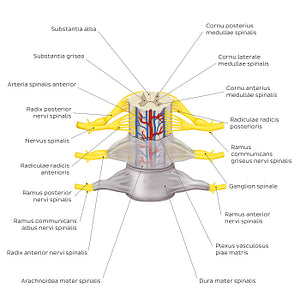Paul Kim
Spinal membranes and nerve roots (Latin)
Spinal membranes and nerve roots (Latin)
The pia is the innermost layer of the three meningeal layers which surround the medulla spinalis. It is highly vascular and closely follows the contours of the medulla spinalis. The second meninx is the arachnoidea, which is separated from the pia by a cerebrospinal fluid filled space known as the spatium subarachnoidale. The thickest and most superficial meninx is the dura, which lies in close proximity to the arachnoidea (but is separated from by a potential space known as the spatium subdurale). The space between the canalis vertebralis and dura is known as the spatium epidurale which contains adipose tissue that helps to absorb shock and protect the medulla spinalis. The arachnoidea and dura form a ‘sleeve’ over the fila radicularia et radices nervi spinalis, whereas the pia reflects onto the root complex and blends with their epineurium. The dura, arachnoidea and pia extend along the medulla spinalis, beyond the conus medullaris to terminate at the lower border of the second sacral vertebra. The radix anterior nervi spinalis contains motor/autonomic nerve fibers which carry impulses away from the systema nervosum centrale towards the periphery. The cell bodies of the radix anterior neurons are located in the cornu anterius medullae spinalis.The radix posterior nervi spinalis contains the central processes of sensory neurons, whose cell bodies are located in the ganglion spinale of the radix posterior nervi spinalis. They carry signals from the periphery to the systema nervosum centrale. Typically, the radix anterior et posterior unite to form a single n. spinalis carrying mixed motor and sensory fibers and exit the columna vertebralis through the foramina intervertebralia.
Normaler Preis
$7.56 USD
Normaler Preis
Verkaufspreis
$7.56 USD
Grundpreis
pro
Verfügbarkeit für Abholungen konnte nicht geladen werden


#F9D20C
#A9695F
#A51912
#5E3246
#FDEC6E und #CCB2AB

